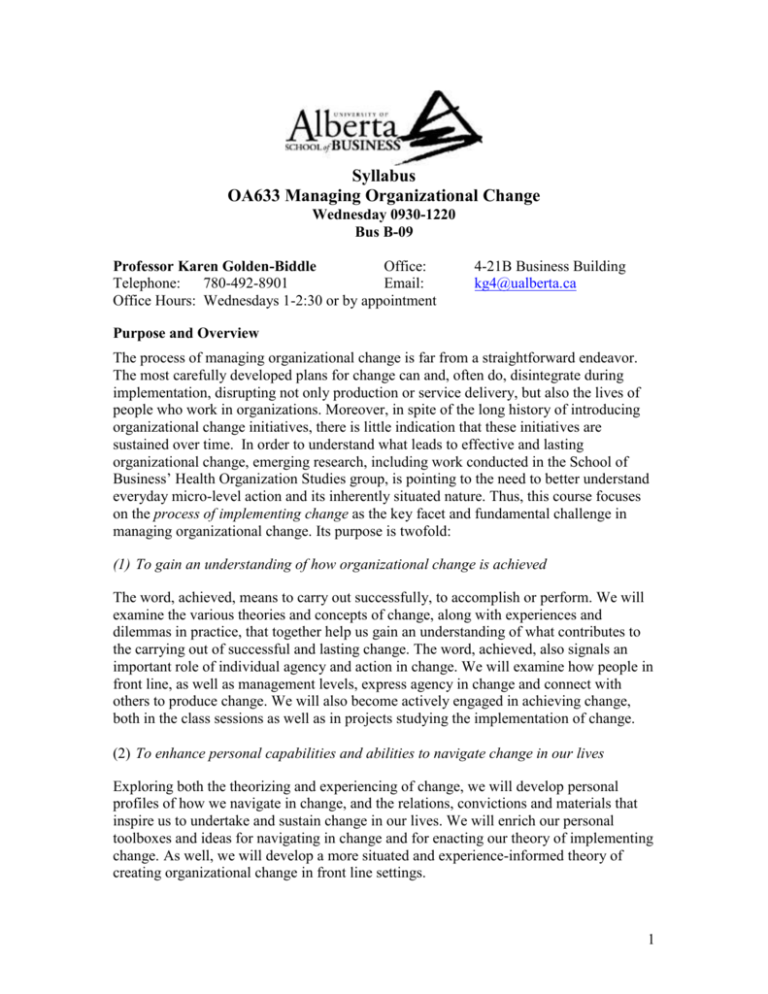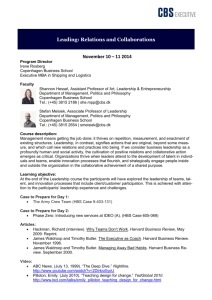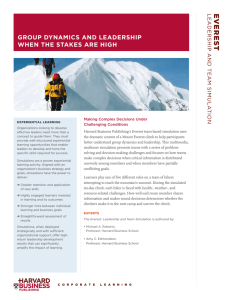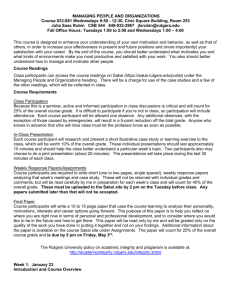Session 7 Navigating political dynamics in change
advertisement

Syllabus OA633 Managing Organizational Change Wednesday 0930-1220 Bus B-09 Professor Karen Golden-Biddle Office: Telephone: 780-492-8901 Email: Office Hours: Wednesdays 1-2:30 or by appointment 4-21B Business Building kg4@ualberta.ca Purpose and Overview The process of managing organizational change is far from a straightforward endeavor. The most carefully developed plans for change can and, often do, disintegrate during implementation, disrupting not only production or service delivery, but also the lives of people who work in organizations. Moreover, in spite of the long history of introducing organizational change initiatives, there is little indication that these initiatives are sustained over time. In order to understand what leads to effective and lasting organizational change, emerging research, including work conducted in the School of Business’ Health Organization Studies group, is pointing to the need to better understand everyday micro-level action and its inherently situated nature. Thus, this course focuses on the process of implementing change as the key facet and fundamental challenge in managing organizational change. Its purpose is twofold: (1) To gain an understanding of how organizational change is achieved The word, achieved, means to carry out successfully, to accomplish or perform. We will examine the various theories and concepts of change, along with experiences and dilemmas in practice, that together help us gain an understanding of what contributes to the carrying out of successful and lasting change. The word, achieved, also signals an important role of individual agency and action in change. We will examine how people in front line, as well as management levels, express agency in change and connect with others to produce change. We will also become actively engaged in achieving change, both in the class sessions as well as in projects studying the implementation of change. (2) To enhance personal capabilities and abilities to navigate change in our lives Exploring both the theorizing and experiencing of change, we will develop personal profiles of how we navigate in change, and the relations, convictions and materials that inspire us to undertake and sustain change in our lives. We will enrich our personal toolboxes and ideas for navigating in change and for enacting our theory of implementing change. As well, we will develop a more situated and experience-informed theory of creating organizational change in front line settings. 1 Course Materials Reading materials for this course are available through the university bookstore. In addition, there will be a charge of 10 euros per student for participating in the online simulation exercise on October 3. We will collect this latter fee during class. Course Assignments OA 633 is a seminar course designed to enhance knowledge of implementing organizational change. Our learning approach will involve not only readings and lectures, but also a lot of activity and working together in various groupings as oriented by the course purpose. The rationale for this approach is simple - implementing organizational change is an active and non-linear process that is accomplished with others and requires an understanding of non-traditional models. Once the due dates are finalized during the first class session, the assignments will be accepted on a late basis only with exceptional cause, incapacitating illness, severe domestic affliction or other compelling reasons (including religious conviction). There are four assignments. Assignment Reflected Exercise Best-Self Points Allocated Feedback 20 Due Date November 19 Class Contribution, including 20 participation in Simulation (10 points for simulation) Each class session and on October 3 Organizational change project 40 Plan Paper Personal change project 20 Plan Sept. 12 1st Writeup Oct. 8 2ndWriteup Oct 29 Final Nov 12 Oct 1 Nov 26 Reflected Best-Self Feedback Exercise: This exercise is designed to help you see the competencies, skills and attitudes that you uniquely bring to your work organization. It asks you to seek input from others that will help you create an experientially grounded 2 portrait of your strengths in navigating change – helping you see who you are when you are at your best in navigating change. Class contribution: You are expected to attend all classes, including the special simulation session, and complete assigned readings before class so that you can contribute to discussion. Your contribution will be evaluated on your participation in the simulation, on your facilitation of in-class exercises and on the quality (not quantity) of your input into discussion, e.g. how well you entertain and build on others’ ideas, introduce new ideas informed by readings, examine contexts of application for concepts. Organizational change project: This is a group project (4-6 members) designed to facilitate your exploration of an aspect of implementing organizational change that interests you. It has two parts. You will complete a two-page write-up on the proposed project, including: (a) a refined topic, (b) description of what you want to examine and (c) a description of how you plan to conduct your examination, and (d) signatures of all group members indicating commitment to proposed plan. Then, you will complete a final paper. All projects must integrate at least 8-10 new articles in addition to relevant course materials, and provide tailored recommendations. You may conduct interviews and collect archival data, provided you follow specified ethical procedures. Maximum length, not including references, appendices, figures or tables, is 20 pages double-spaced. Personal change project: This is an individual project in which you will identify a desired personal change to implement this term. It involves: (1) a written plan – the change goal and expected process for implementing the change, (2) two reports during the term detailing your progress and reactions on carrying out the process, identifying ways you connect with others to gain support and achieve momentum in your change, and examining how you are drawing on your strengths and awareness of your limitations to enhance your implementation, and (3) a paper (up to 3 pages) detailing your key learnings about implementing this change and their applicability to implementing organizational change. This discussion needs to integrate ideas from the course that were most insightful for you in implementing this change. Course Grading: There is a possible 100 total points for course assignments. I will mark each assignment in points and will cumulate them to assign your earned grade, based on the new U of A grading system. The description can be found at http://www.grades.ualberta.ca/?ref=2 and at http://www.ualberta.ca/~unisecr/policy/sec61.html#6 Course Norms: We will create the opportunity during the first class session to establish norms that are helpful in enhancing our learning. 3 Course Schedule and Class Description/Preparation Session 1 Introducing the course and September 3 Focusing on the change process Class Preparation: 1. C. Fredman, 2002. “The IDEO Difference,” pp. 52-57 in Hemispheres, Magazine of United Airlines. August. 2. Can you recall a time when you felt most alive, most involved and/or most excited about your involvement in creating change in your organization? What made it so? Please come to class prepared to discuss this experience. Session 2 Theorizing how change occurs September 10 Class Preparation: 1. D.A. Nadler and M.L. Tushman, 1989. “Organizational Frame Bending: Principles for Managing Reorientation,” Academy of Management Executive, 3:194-204. 2. M. Wheatley, 1994. “Searching for a Simpler Way to Lead Organization” (Introduction), pp.1-13; and “The New Scientific Management” (Chapter 8), pp.139-147; in Leadership and the New Science. Berrett-Koehler Publishers, Inc. 3. Develop a model, picture, map or figure showing the similarities and differences between the two different ways of theorizing change in the articles for this week’s class. Session 3 Everyday leading in change September 17 Class Preparation: 1. D.E. Meyerson, 2001. “Radical Change the Quiet Way,” Harvard Business Review. October. 2. Q. N. Huy, 2001. “In Praise of Middle Managers,” Harvard Business Review. September. 3. What strategies of everyday leading in change, depicted in this week’s readings, most resonate with how you seek to lead in change? Which ones might you like to try? No class September 24 (simulation as substitute) Session 4 Seeing and creating opportunities in change October 1 Class Preparation: 1. T. Reay, K. Golden-Biddle and K GermAnn, 2003. “How Nurse Practitioners and Middle Managers are Acting to Create Work Role Changes. Best Papers Proceedings of the Academy of Management in Seattle, Washington. 2. M. Tyre and W. Orlikowski, 1994. ”Windows of Opportunity: Temporal Patterns of Technological Adaptation in Organizations,” Organization Science. Volume 5(1): 98-118. 3. Identify an occasion in change when you acted at the right time. Describe it. What made this the ‘right’ time to act? How did you shape the situation and change by acting at this time? 4 Sessions 5/6: Simulating change October 3 Class Preparation: 1. Simulation User Manual Session 7 Navigating political dynamics in change October 8 Class Preparation: 1. Case: “John Smithers: Change Agent” Harvard Business School Case. a. What should John do now? b. Compare John’s situation with those you have faced. What guidance can you give John? c. What insight into John’s situation do the readings provide? What are some general learnings in navigating political dynamics in change and surviving them? 2. L. Hill, 1995. “Power Dynamics in Organizations,” Harvard Business School Note. 3. B. Oshry, 1993. “Converting Middle Powerlessness to Middle Power: A Systems Approach” In: T. Jick (Ed). Managing Change: pp.401-412. Session 8 Developing an innovating culture October 15 Class Preparation: 1. Case: “IDEO Product Development” Harvard Business School Case a. How do you describe IDEO? How does innovating in IDEO work? b. What decision should IDEO make on the Handspring project? c. What insights into developing an innovating culture does the case/reading provide? 2. A. Hargadon and R. Sutton, 2000. “Building an Innovation Factory,” Harvard Business Review, May-June: 157-166. No class on October 22 (substitute for simulation) Session 9 Instituting positive organizing practices in change October 29 Class Preparation: 1. Case: “Southwest Airlines: Using Human Resources for Competitive Advantage (A)” Stanford Graduate School of Business Case. a. How do you describe Southwest? What characterizes it for you? b. What should Ann recommend when the Executive Committee meets? What should she say about potential imitation of Southwest’s human resource practices? c. What insights into instituting positive organizing practices do the case and readings provide? 2. J. Dutton and E. Heaphy, 2003. “Coming to Life: The Power of High Quality Connections at Work”. In K. Cameron, J. Dutton, R. E. Quinn, Positive Organizational Scholarship, San Francisco: Berrett-Koehler. 3. J. H. Gittell, 2001. “Investing in Relationships,” Harvard Business Review, June. 4. http://www.fastcompany.com/realtime/florida/rlewin.html “Relationships: The New Bottom Line.“ This is chapter 1 from Roger Lewin and Birute Regine, Weaving Complexity and Business, New York: Textere, 2001. 5 Session 10 November 5 Class Preparation: Navigating change amidst different beliefs 1. Review materials from October 15 and October 29 classes 2. In-class exercise. Session 11 Navigating cultural dynamics in change November 12 Class Preparation: 1. E. H. Schein, 1999. Why Does Corporate Culture Matter? In The Corporate Culture Survival Guide, San Francisco: Jossey-Bass Publishers: 3-58. 2. J. Martin, 2002. “Chapter 4: Single Perspective Theories of Culture,” In Organizational Culture. Sage Publications. 3. Identify an important change in your current or prior organization. Did and if so, how did members’ convictions and other beliefs shape the implementation of the change? How did implementing the change in turn shape members’ beliefs and convictions? Session 12 Creating a reflected best self portrait in change November 19 Class Preparation: 1. R.S. Zander and B. Zander, 2000. Chapter 3, “Giving an A” and Chapter 4, “Being a Contribution” In The Art of Possibility. Penguin Books. 2. Looking again at your portrait, what stands out for you – what is surprising, gratifying, most noticeable to you? Explore this a bit in whatever way works for you. What makes it stand out or be gratifying or surprising for you? How do you draw on this to navigate change? Session 13: November 26 Collaborating nontraditionally on change research and Summarizing the course Class Preparation: 1. K. Golden-Biddle, T. Reay, C. Witt, S. Petz, A. Casebeer, A. Pablo, and C.R. Hinings, 2003. Toward a Communicative Perspective of Collaborating in Research: The Case of the Researcher-Decision Maker Partnership. Journal of Health Services Research and Policy. 2. Reflecting on the course this term, what stands out as memorable for you? What ‘takeaways’ will you perhaps call upon as you navigate and manage present and future change? 6







